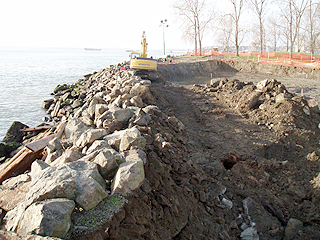
DJC.COM
January 18, 2007
Complicated project packs a few surprises
Barrientos

Schwartz
|
When Maria Barrientos was asked in 2000 to assist the Seattle Art Museum in managing the design and construction of a 9-acre sculpture park on one of the last open waterfront sites on Elliott Bay, she jumped at the chance.
The fact she had not managed a sculpture park project before did not stop her because, who else had? At that time the company was completing the renovation of Seattle’s McCaw Hall, and she was excited at the opportunity to become involved in another monumental project.
Her previous experience developing golf courses before she moved to Seattle 20 years ago was about as close to this endeavor as any. Little did we know then just how complicated a project this would be.
Assembling the team

Photo courtesy of Barrientos Crews placed 68,000 tons of rock, sand and gravel to build an 850-foot-long ‘habitat bench’ that will protect salmon and provide seismic reinforcement for an aging seawall. The final step in building the beach occurred in the middle of a stormy winter night, when workers could take advantage of the low tide. |
The first step was to assemble a world-class design team. After an international search, Weiss/Manfredi was selected to form the nucleus of the team engaged in the design of the project.
Once the design team and SAM had developed the guiding principles for the overall design — a concept that connected the three primary parcels that comprise the site with a gently sloping, angular pathway — the challenging work of incorporating a myriad of technical requirements into that concept began.
Balancing goals
We quickly realized that building a large park over two streets and a railroad is not the same as constructing a building.
This project would require expertise in just about every type of construction, particularly civil construction. Marine work, large bridges, extensive earthwork components, landscaping, street work, and of course, the pavilion and the assembly and placement of the art would all be integral parts of the construction process.
The site had been used for nearly 60 years as an oil storage and distribution facility. Despite previous cleanup efforts, the site remained under a consent decree that required additional measures to mitigate the remaining environmental issues.
These measures included the addition of 200,000 cubic yards of soil as a thick “cap” across the site, sealing any potential vapors below the cap and preventing water from infiltrating the remaining impacted soil.
The design of the project needed to be flexible. The desire to incorporate change, in both art and technology, necessitated the inclusion of a substantial “technology backbone” throughout the park. Landscape materials had to be evaluated for how they would appear in the park’s early years as well as how they would appear in maturity.
It was a complex and exciting challenge to figure out how the sculpture park could stand alone as a work of art while serving as a backdrop for other works.
The permitting maze
Early in the project, we developed a list of permits that would be required to complete the project. That original list of 40 permits grew to over 60 by the end of the project. Numerous permits required coordination between city, county, state and federal agencies to gain approvals.
In an early visit to the Department of Planning and Development, for example, the simple goal was to establish addresses for the six different parcels that comprise the site.
After walking through the complex ownerships of each parcel, (three owned by SAM, one owned by the Museum Development Authority, three portions of city streets, one portion of a city park, two parcels underwater — one owned by the state Department of Natural Resources), the DPD staff person had an unsettling blank look. After explaining the situation to a supervisor, and six more weeks of DPD research, we were able to establish addresses for the permit submittals.
At the time we submitted the building permit documents, the project included plan sets that exceeded 425 sheets. On submittal day, we had the printer deliver the plan sets directly to the city. When we arrived for the intake appointment and checked in at the counter, we asked where our delivered plan sets were.
The staff person responded, “Oh, so you are the folks responsible for that mountain over there.”
It took several cart trips to move the drawings to the intake desk and start the process. The intake appointment took almost four hours and we stamped the roughly 3,000 sheets for the building permit application. This process was repeated twice for permit correction submittals.
SAM’s decision to include a shoreline enhancement component in the project required some of the most complex permitting efforts we had ever encountered.
With Puget Sound chinook salmon listed as an endangered species, all of the proposed in-water work required intense scrutiny by multiple agencies. Some of these agencies are not known for their rapid permit reviews, and the Endangered Species Act listing only complicated those reviews.
Despite those obstacles, our team was able to keep the permits moving through the process, and we obtained these permits within nine months.
Building the beach
The clean and simple geometries of the completed site belie the complexity of realizing that achievement. Borrowing highway construction techniques such as mechanically stabilized earth and massive steel bridges — and melding them with more conventional landscape and architectural approaches — we achieved a unique urban setting that will continue to evolve for generations.
Among the keys to completing the project, sequencing and scheduling were perhaps the most important. When faced with the task of importing over 200,000 cubic yards of soil to establish the site grades — much of that work occurring in the winter months — planning the work in an efficient manner was essential. That planning also had to be able to accommodate weather-related obstacles, such as over 30 straight days of rain last winter and November’s record rainfall.
The waterfront components of the site provided many challenges. After convincing the city Department of Transportation that our design for the 850-foot-long habitat bench would also provide seismic reinforcement for the aging seawall, we started placing the 68,000 tons of rock, sand and gravel that form this habitat enhancement and public beach.
The final step in building the beach occurred in the middle of a cold and stormy February night to coincide with the low tide.
After excavating and constructing the back beach, the final “breaching” necessary to construct the lower slopes and subtidal portions occurred. With rain blowing horizontally in the 40 mph winds, two huge excavators grabbed the large rock that remains in front of the beach and kept moving it down slope with the tide.
A large barge-mounted crane that had been positioned in front of the breach was moving buckets of sand and gravel over the excavators and dropping them onto the beach behind them for two bulldozers to spread and form the beach contours.
The next morning broke clear and surprisingly calm, and the completed beach looked as though it’s always been there — a stark contrast from the violent activity of the previous night.
John Schwartz provides owner representation, project management and construction management services at Barrientos.
Other Stories:
- Park fits Seattle to a Z
- Sculpting an oasis from a blighted landscape
- Risky site inspired creative thinking
- Landscape grounded in Northwest natural history
- Engineering the path took a lot of twists and turns
Copyright ©2009 Seattle Daily Journal and DJC.COM.
Comments? Questions? Contact us.